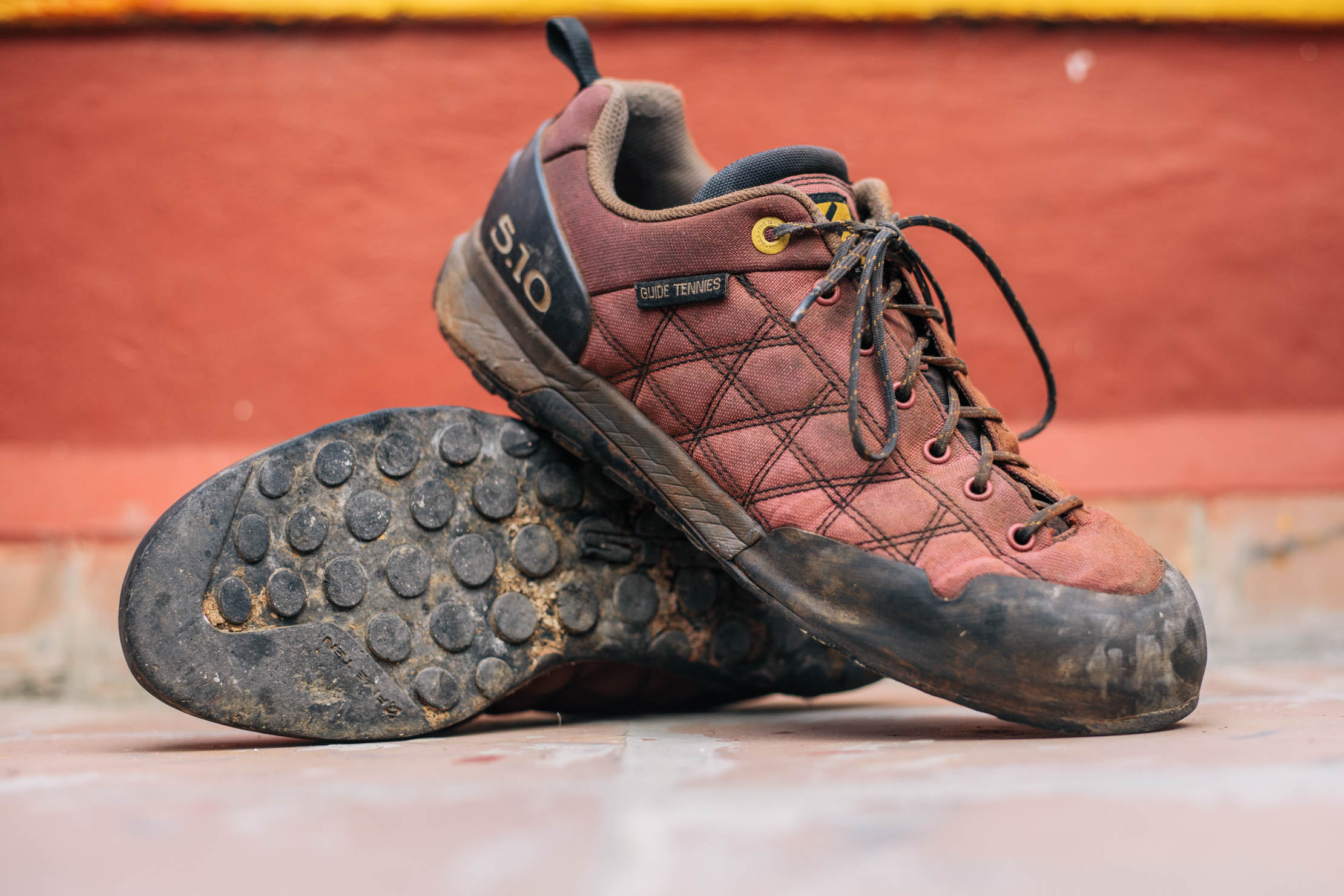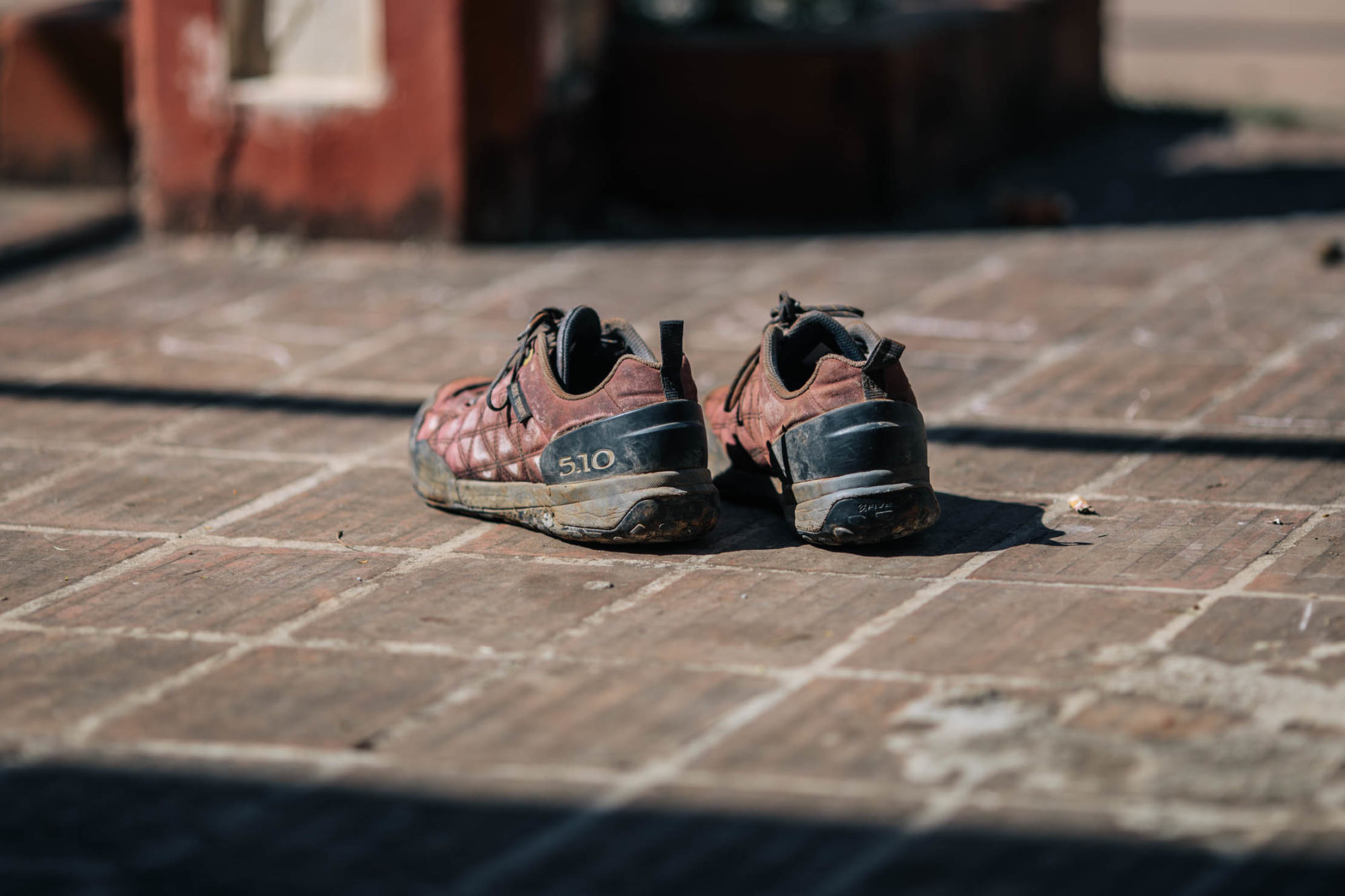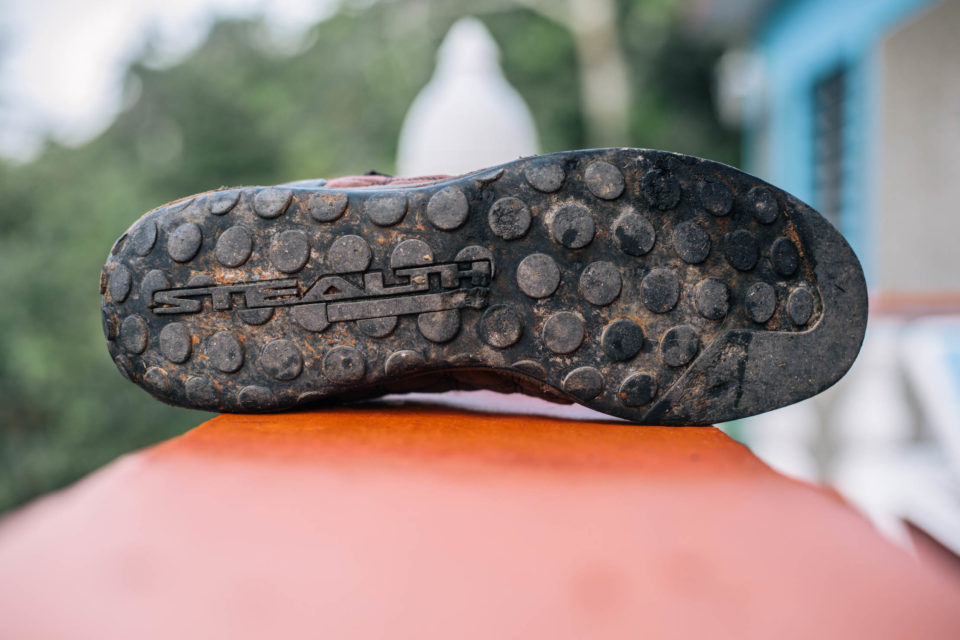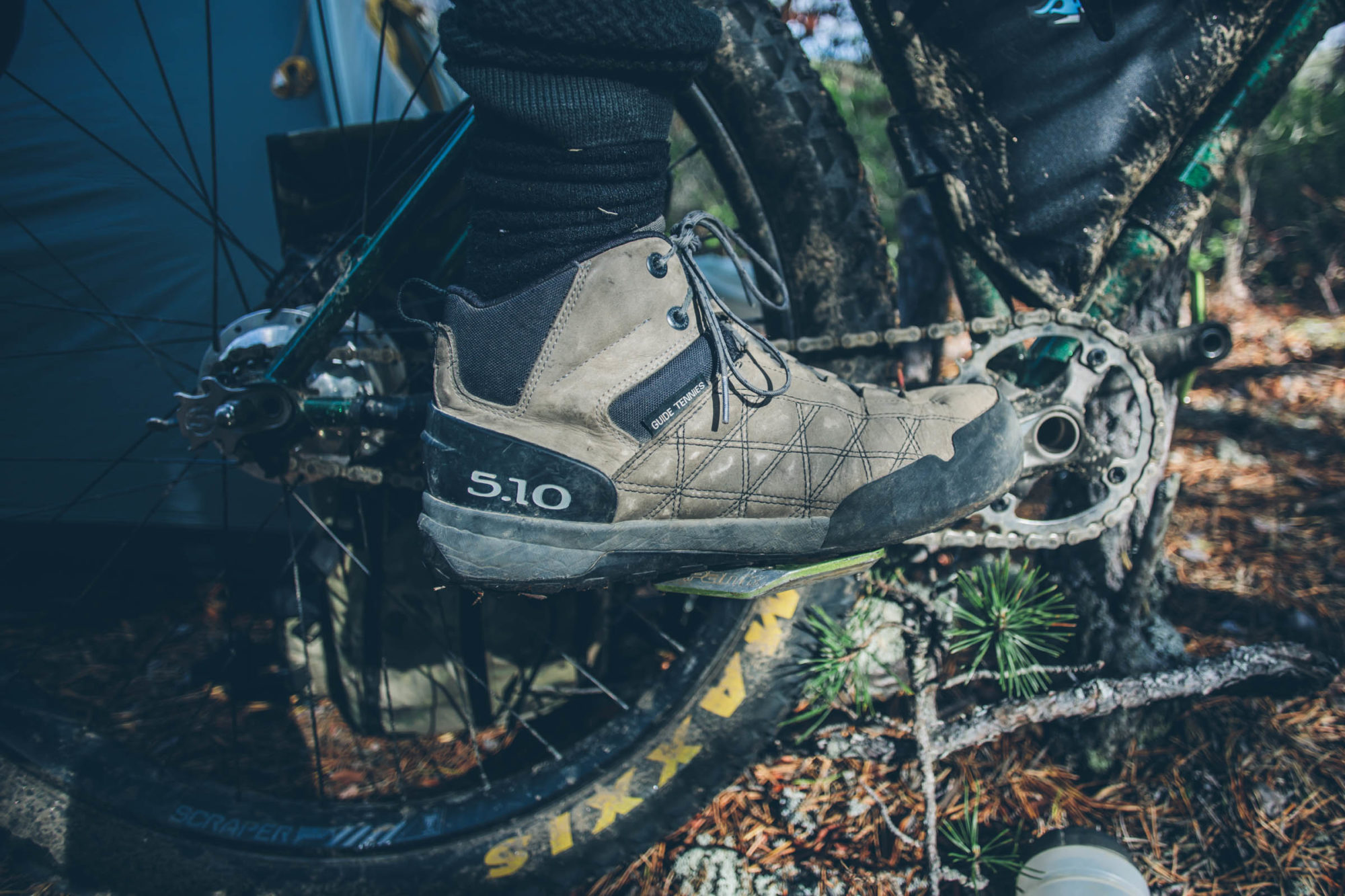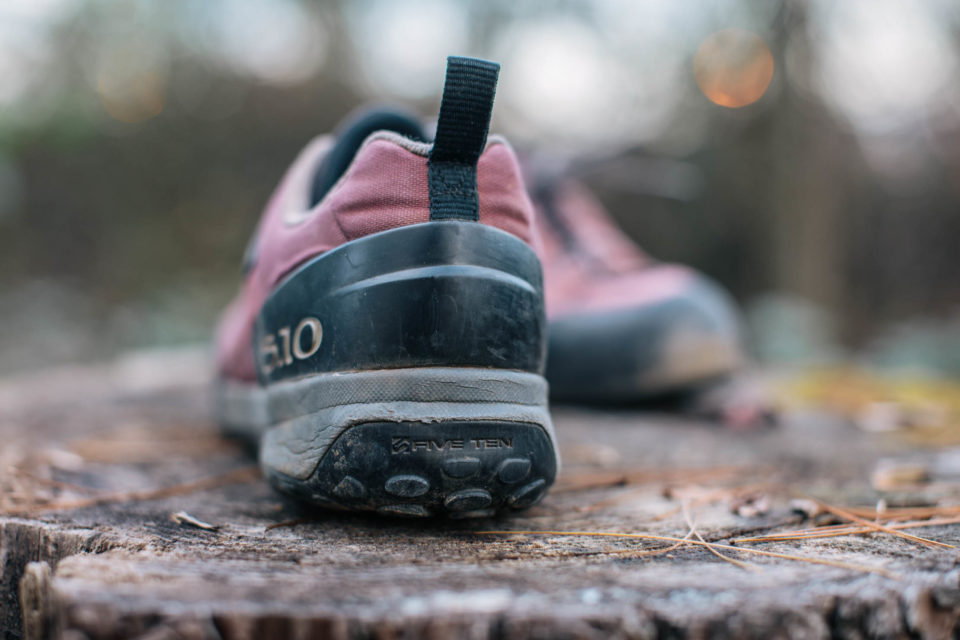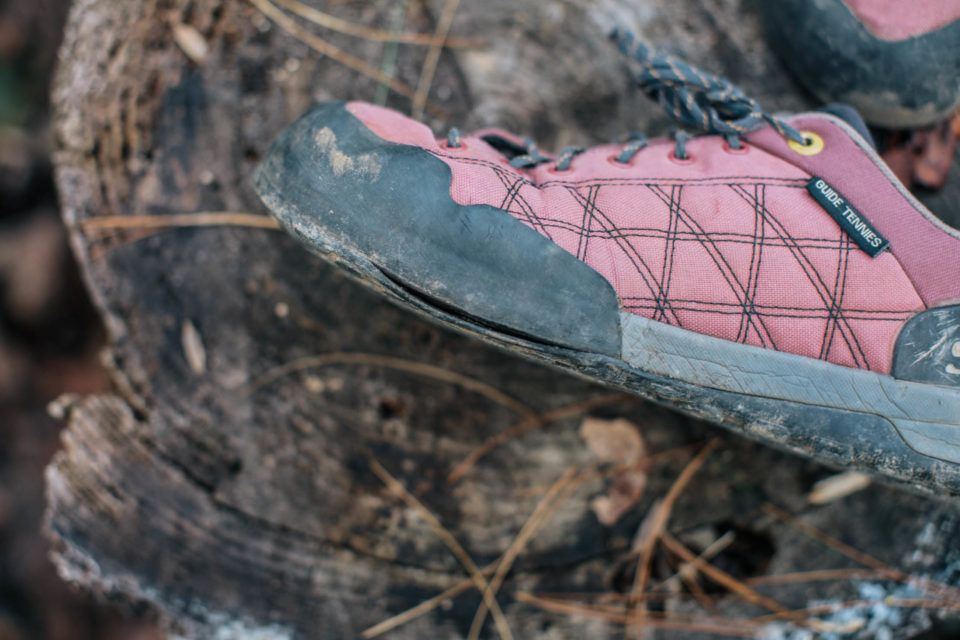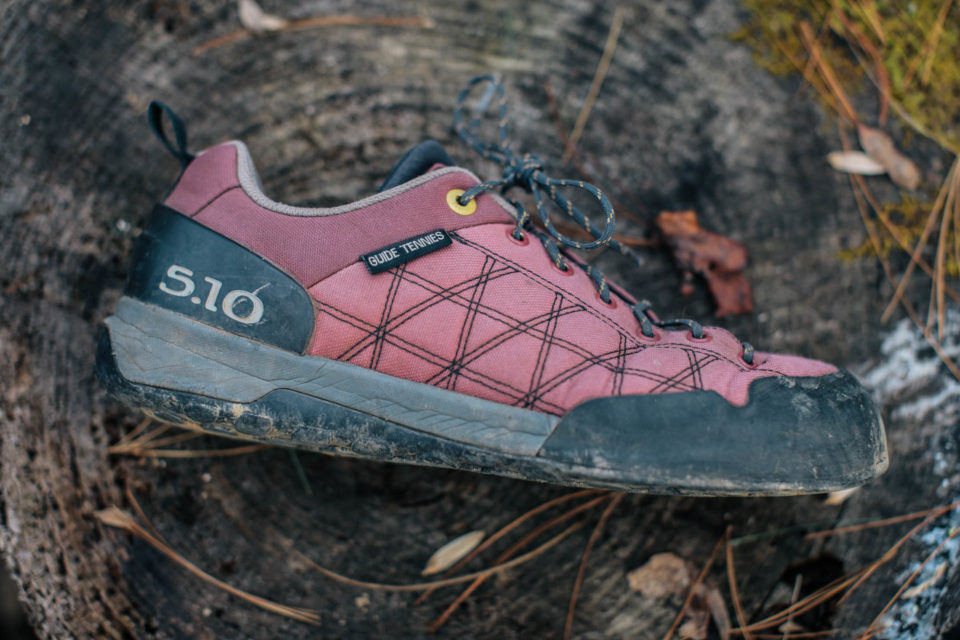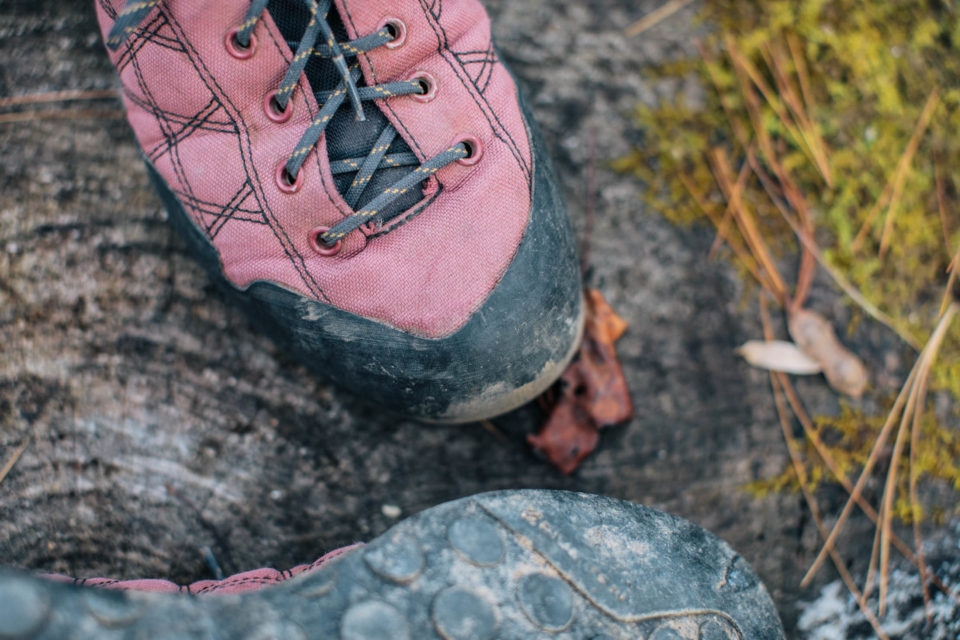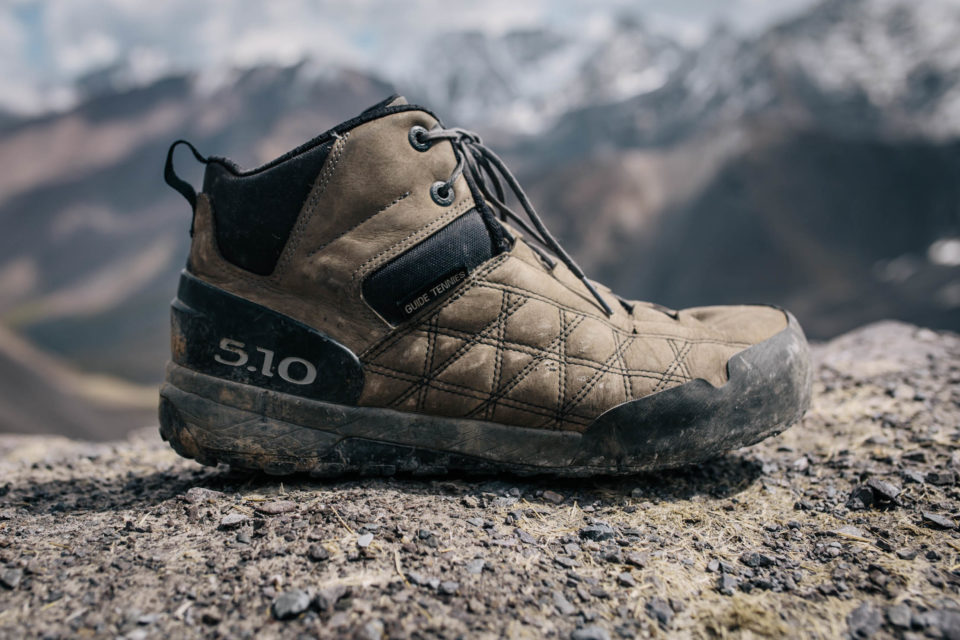Five Ten Guide Tennies Review: Bike Traveling Shoes
This pair of Five Ten Guide Tennies has seen almost 4,000 miles of walking, pedaling, and hike-a-biking. They’ve been through muddy, rocky, wet, and bone-dry conditions in Cuba, Uganda, Rwanda, and the southeastern US… and they’re still going. Are Guide Tennies the best bike travel shoes available? Find out in this ultra-long-term review…
To acknowledge all that these Five Ten Guide Tennies have accomplished, a proper Curriculum Vitae is in order: Purchased in mid-2014, these brick-red Tennies were subsequently shaken down on a few trail rides around Pisgah National Forest. Later that year, they flew into Entebbe International Airport, from which they embarked on the 1,300 mile hot and dusty—and rainy and muddy—Trans Uganda bikepacking route. During their time in the Pearl of Africa, they also took many long walks and hikes, including a rugged jaunt into the Mountains of the Moon where they caught a glimpse of the world’s only equatorial glaciated peaks. Next, they racked up few hundred more miles through Rwanda, where they ultimately tackled the Congo Nile Trail and a hearty bushwhack through Nyungwe National Park. After Africa, the pair flew back to the US and went on a few more bike outings. They were also worn for months during a major house remodel. After that, they set sail to Cuba to take on the 860-mile La Ruta Mala, climbing and pushing over the three mountain ranges on the island. Since then, these faded—now pinkish—Guide Tennies have been ridden a couple dozen more times, loaned to a friend for a few rides, worn to dinner on occasion, taken on photo shoots and to the local pub, etc. After all that, they’re still comfortable, supportive, and have plenty of sticky tread. Need I write more?
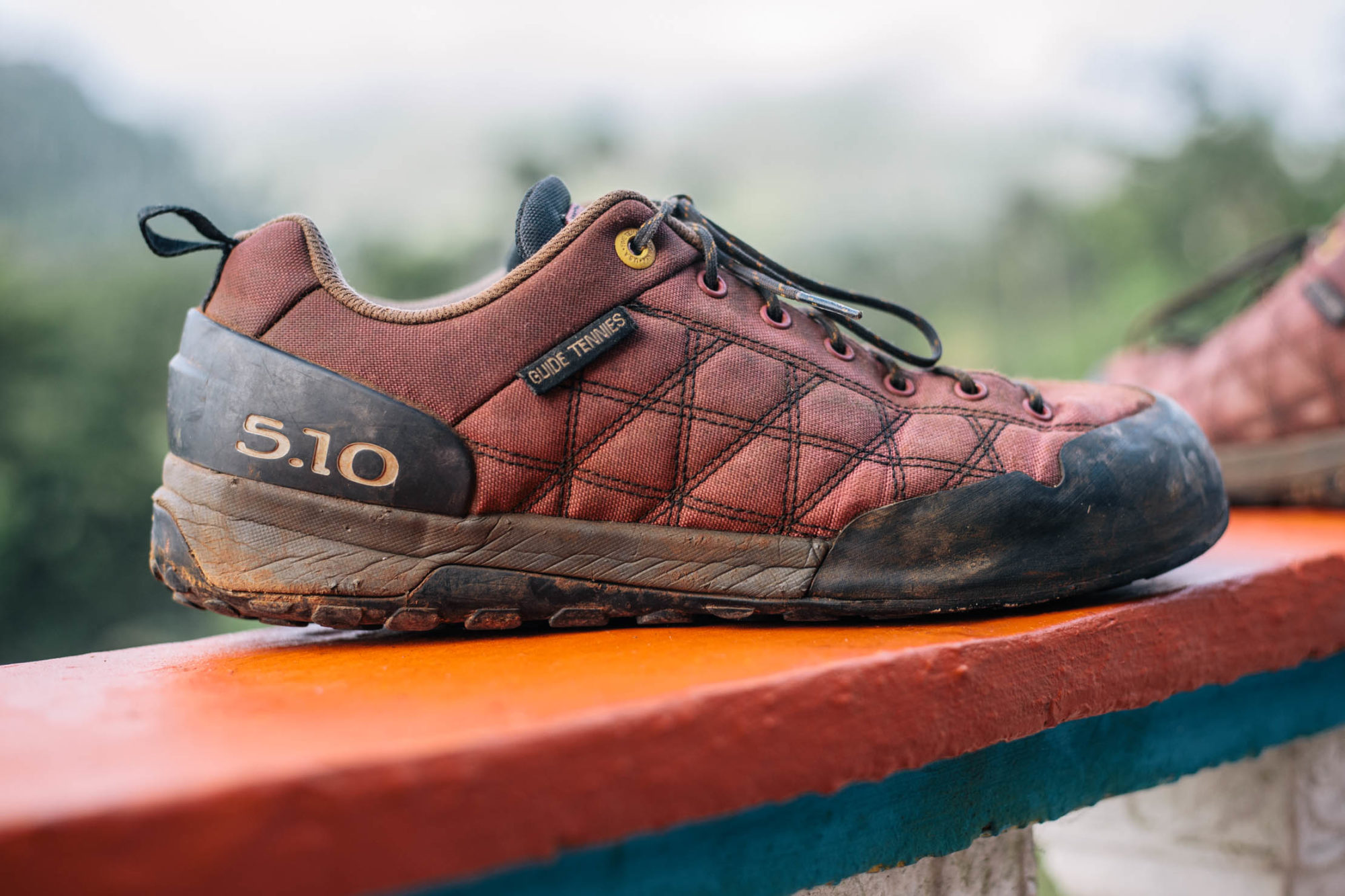
First, let me adress the debate that inevitably ensues whenever we post about flat pedals or non-SPD shoes for bikepacking. I get it. I’m a recovering clipless addict. I still run SPD pedals on my mountain bike and drop-bar bike, sometimes. However, I find myself reaching for platform pedals more and more. I even slapped a pair of flats on a gravel bike for an 80-mile, 10,000’ overnighter the other weekend, something I would have considered ludicrous just a couple years ago. I used to swear by clipless for pedaling efficiency and performance, but the more I ride good flats with quality shoes, the more the merits of clipless fade into obscurity.
When it comes to big bike trips, I’m a hardline flats convert. It’s hard to dispute the virtues of a comfortable pair of shoes when your trip includes everything from long hike-a-bikes, to exploring city streets by foot, to scrambling up mountainsides for photos, to 12-hour days spent pedaling. And while there are a few clipless shoes that are tolerable in these situations, they are never as comfortable as shoes without cleats. When companies claim an SPD shoe is good for “walking around,” that’s a relative statement. For the most part, SPD shoes simply can’t compete with flats in any category other than pedaling, and they often fall short in comfort there, too. By and large, if you pick quality shoes and good flat pedals, your pedaling efficiency won’t suffer significantly either.
In that matter, quality is the operative word. Good, grippy pedals are an integral component, as are good shoes. Most people can make do with any old pair of hiking shoes or boots, or even sandals, but if you’re concerned with performance, support, and durability, there seem to be just a few options that can maximize pedaling productivity and hold up to the rigors of a long bike trip. Much of this hinges on having the right rubber sole – one that grips the pedals, provides just the right amount of stiffness, and features a rubber compound that won’t wear out. This is a tall order, but one that’s key to taking on a big bikepacking trip. The Five Ten Guide Tennies definitely tick those boxes.
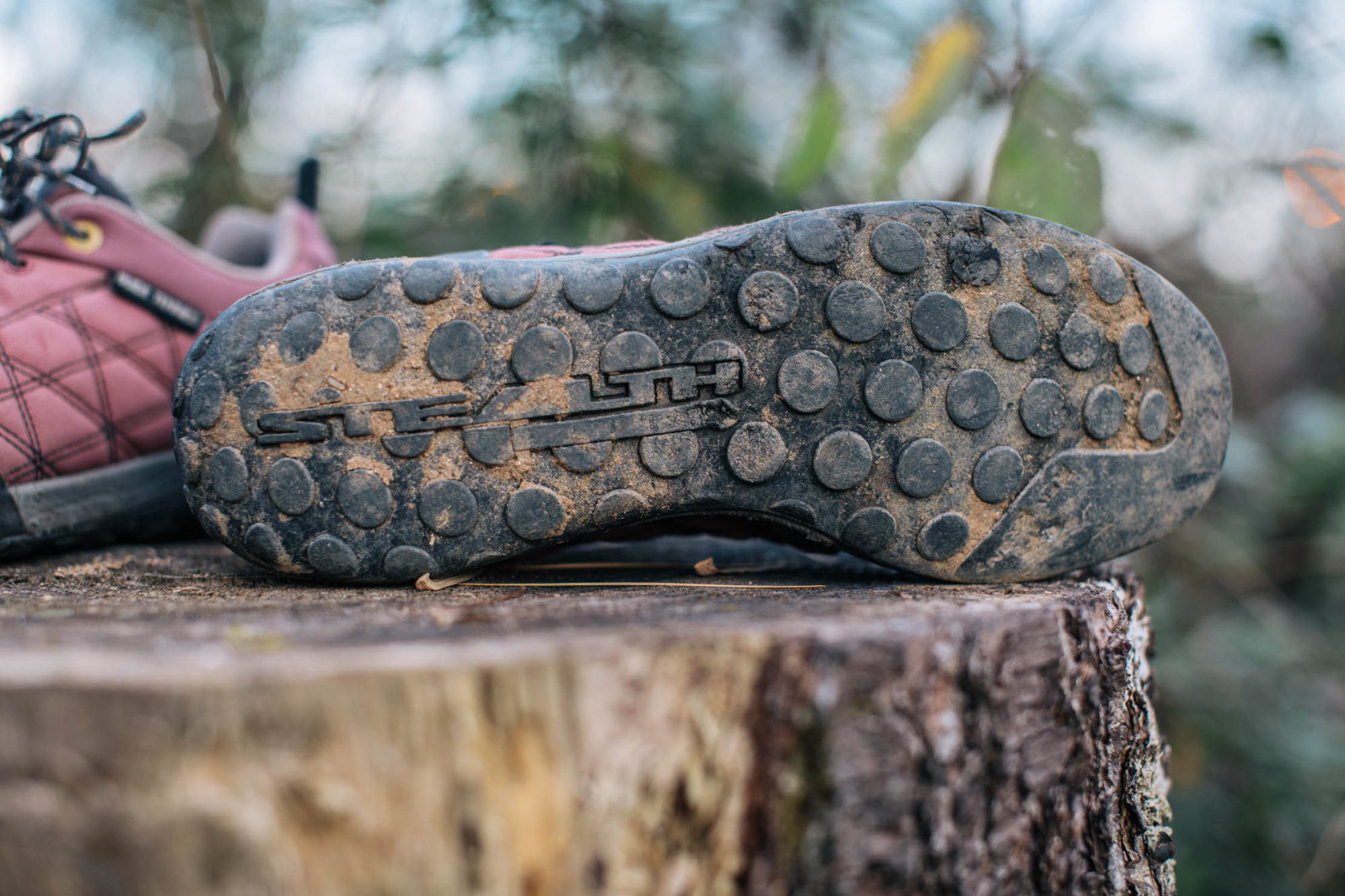
Rubber Meets The Road
While Five Ten (now under the Adidas brand) makes cycling footwear, the Guide Tennies actually aren’t bike shoes. They probably should be, but they’re technically classified as approach shoes, meaning they are in a category of hybrid footwear that have some characteristics in common with hiking boots, and others with rock climbing shoes. In essence, they are designed for hiking and scrambling to go rock climbing, as well as light rock climbing. These activities are a far cry from bikepacking, but the magical rubber used on the soles of the Guide Tennies make them a great crossover shoe. There are quite a few purpose-built flat shoes for mountain biking these days, but many, such as the Five Ten Freerider Contact, have soft, ultra-sticky rubber that simply won’t last. The sole and exterior toe box on the Guide Tennies are constructed from Stealth C4, one of several proprietary rubber compounds in Five Ten’s lineup. According to their marketing, “C4 allows climbers to stick to barely there edges, lock into smears on microscopic nubbins, and cruise up technical terrain with unparalleled confidence.” It is sticky; not as sticky as the S1, but it’s definitely grippy enough to keep your feet glued to the pedals during the mid-stroke, which is where most non-cycling shoes fall short.
Stealth C4 is also harder than the compounds that Five Ten uses on their enduro-focused flat shoes, which helps account for the superior durability that I’ve experienced. Unlike the S1 rubber on the Contacts, the C4 doesn’t get chewed up by aggressive pedal pins. In fact, after all the miles on this pair, there is very little evidence of bite marks.
I assumed that the stickiness of the C4 rubber would start to degrade over time, but that doesn’t seem to be the case. I rode these just a few weeks ago and they still stick to the pedals—perhaps not quite like when they were new, but still surprisingly well. Five Ten uses their iconic “Dotty” pattern on the Guide Tennies, which I’ve found to be just enough tread for most hike-a-bike situations, although they can get a little slippery on muddy or really loose surfaces, especially limestone “kitty-litter” hiking situations.

Under Construction
The Five Ten Guide Tennie actually started the approach shoe category some 30 years ago. Since then, Five Ten has applied a few changes to the shoe, including big performance upgrades as well as small tweaks to shave off grams. Since I purchased this pair, they have undergone a few design changes. They still have the same general design, featuring a compression-molded midsole, but they also added extended lacing and a pass-through woven eyelet on the tongue that should help keep it from sliding to the side, one issue I had with the older version. Another change is that Five Ten seems to have done away with the fabric version, offering the Guide Tennie exclusively with a Suede/Synthetic upper.
As for changes, Five Ten was purchased by Adidas in 2012. There’s nothing wrong with that, really, but I do get nervous when good things change. Hopefully, the Guide Tennies don’t get over-tweaked for the worse, or, gasp, discontinued.
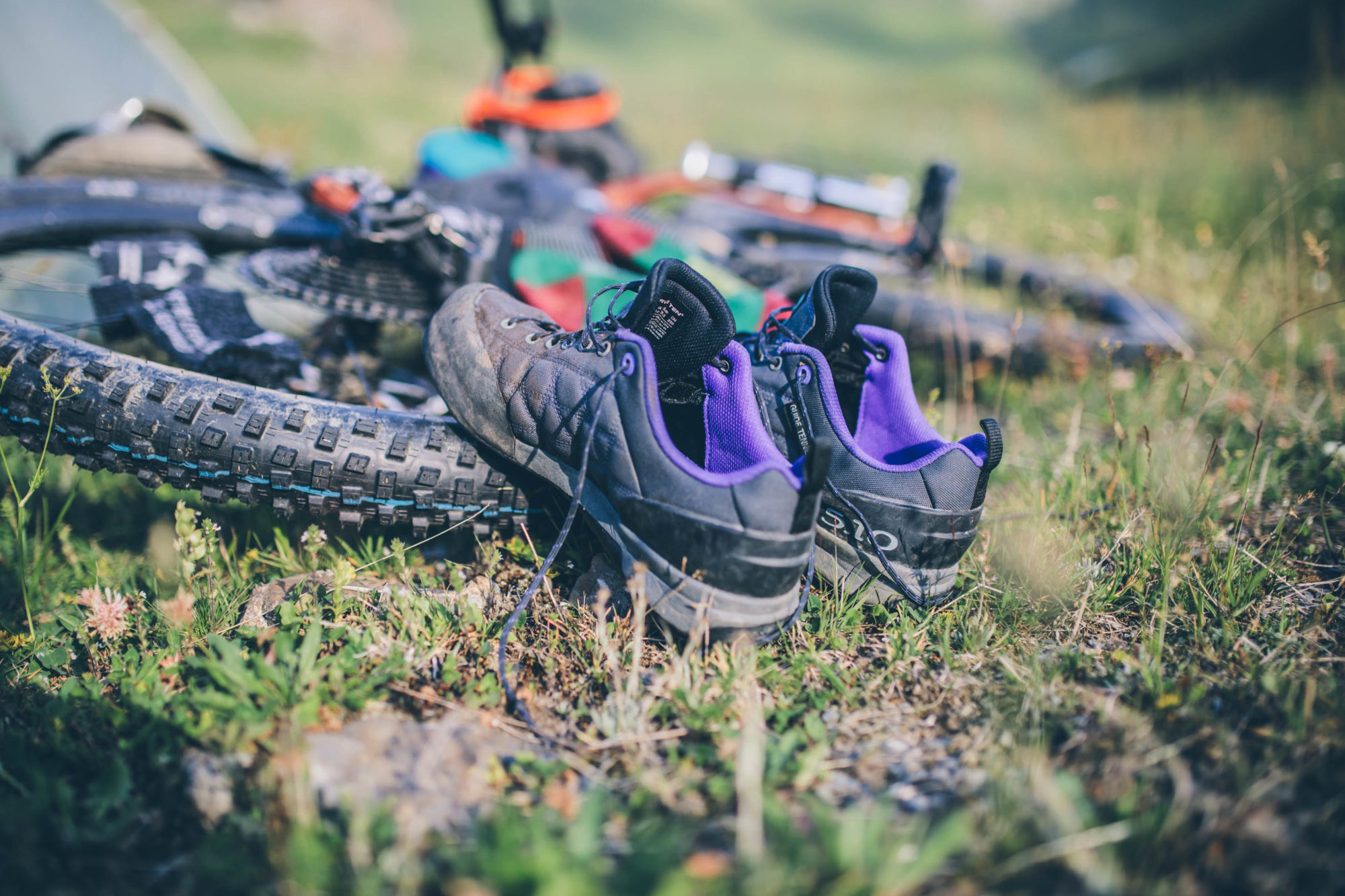
Men’s and Women’s Fit and Sizing
From what I can tell, the sizing of the Guide Tennies is pretty straightforward. I almost always wear a 9.5 US, and that’s what size my Guide Tennies are. Also, Virginia consistently wears a women’s 8.5 US, and the Guide Tennies in that size fit her perfectly. I have seen a couple complaints that folks with very wide feet have sizing issues, but that’s unconfirmed.
The Five Ten Guide Tennie used to come in a multitude of colors, but it appears that Adidas has cut the lineup to four color variations in men’s (Tent Green, Gun/Metal, Navy/Orange, and Twine). These come in sizes 4 and up, including half sizes. For women’s they now only offer it in two color schemes (Gray/Fuschia and Stone) in sizes 5-11, including half sizes.
Five Ten used to offer a mid-top version of the shoe (shown below, which I wore in Kyrgyzstan), but, unfortunately, Adidas/Five Ten have apparently discontinued it from the Guide Tennie lineup. There’s no information available as to if or when they’ll be releasing these again.
Pros
- C4 rubber is sticky, but not too soft, and lasts forever
- Sole provides the perfect amount of stiffness that’s comfortable off the bike and still provides solid support while pedaling
- Comes in a nice variety of colors and sizes in both men’s and women’s
Cons
- The Dotty rubber pattern is great on rocks and harder surfaces, but can get a little slippery in wet or loose terrain; definitely not a deal-breaker though
- No lace keeper for cycling
- Lack of gusseted tongue allows dirt and gravel into the shoes
- Weight (Men’s 9.5, as tested) 808g (28.5oz) per pair
- Size Tested Men’s 9.5, Women’s 8.5
- Place of Manufacture China
- Price $120
- Manufacturer’s Details Link
Wrap Up
In closing, let me state why I am writing a review of a four-year-old product. I’ll use your favorite T-shirt as analogy. You know, that old T-shirt that you’ve been wearing so long it’s taken on a sentimental quality. As it started to get holes in the shoulders, you wore it less and less because you wanted it to last forever. Really, though, you just wish you could buy the same shirt again and again. That sums up my relationship with Five Ten’s Guide Tennies. That is, I don’t want them to go away.
That said, as mentioned in the cons, these shoes aren’t without their faults. All we can hope is that Adidas keeps the Guide Tennie going and only refines it slightly, without messing up a nearly perfect product. Ideally, Adidas would make the Guide Tennie a cycling shoe and make just a few minor changes, such as a gusseted tongue and a lace-keeper. Otherwise, for bike travel, Five Ten Guide Tennies are next to perfect as they are, in their comfort, support, and stiffness, which says a lot.
Please keep the conversation civil, constructive, and inclusive, or your comment will be removed.






